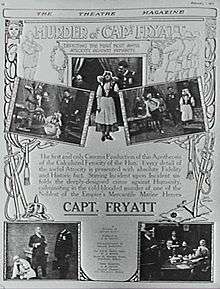The Murder of Captain Fryatt
The Murder of Captain Fryatt is a 1917 Australian silent film about the execution of Captain Charles Fryatt during World War I from John and Agnes Gavin. It is considered a lost film.
| The Murder of Captain Fryatt | |
|---|---|
 Poster for the film | |
| Directed by | John Gavin |
| Produced by | John Gavin |
| Written by | Agnes Gavin[1] |
| Starring | Harrington Reynolds John Gavin |
| Cinematography | Franklyn Barrett |
Production company | Australian Famous Feature Company |
| Distributed by | John Gavin |
Release date | 26 February 1917[2] |
Running time | 44 mins (four reels)[3] |
| Country | Australia |
| Language | Silent |
Plot
The Gavins claimed the plot "followed closely the facts contained in the official report of the British Admiralty" about the Fryatt incident, with a Belgian love story added.[4] The film begins after Fryatt, the commander of a merchant ship, has rammed a German submarine, and has returned to London a hero. German spies seek to track him down. Fryatt goes on another voyage, is captured by the Germans and executed.
Cast
- Harrington Reynolds as Captain Charles Fryatt
- John Gavin as Von Kehlen
- Olive Proctor as Mrs. Fryatt
- Augustus Neville
- Charles Villiers
- Roland Watts-Phillips
- Mabel Fish as Baby
- Percy Walshe
- Clara Stevenson
- Elsie Prince
Production
Fryatt's murder was one of the three best known German atrocities of World War I, the others being the sinking of the RMS Lusitania and the execution of Nurse Edith Cavell. Gavin sought official approval from the New South Wales Chief Secretary prior to making the film. This was given, provided the actual execution of Fryatt was not shown. Production was very swift – Fryatt was killed on 27 July 1916 and the film was ready for screening in February 1917.[5] The script was reportedly based on British admiralty naval reports.[6]
Agnes Gavin copyrighted her script on 17 February 1917.[7]
The film was a follow up to the Gavin's popular hit The Martyrdom of Nurse Cavell (1916), the success of which enabled Gavin to take out a lease at a studio in North Sydney. He announced plans to make four films continuously of which this was to be the first.[8] During filming a sequence in North Sydney where soldiers raid a haunt of German spies, some bystanders joined in and had to be restrained by the police and John Gavin from smashing the plate glass in front of the shop.[4] Reportedly over five hundred people were involved in the production.[8]
Reception
Although the film's tone was similarly anti-German to Nurse Cavell it was not as successful at the box office.[5][9]
References
- Copyright registration of film at National Archives of Australia
- "Advertising". The Sunday Times. Sydney. 18 February 1917. p. 16. Retrieved 3 October 2013 – via National Library of Australia.
- "Advertising". The Cairns Post. Qld. 26 July 1918. p. 1. Retrieved 25 February 2012 – via National Library of Australia.
- "THE STAGE". The Queenslander. 15 December 1917. p. 29. Retrieved 9 January 2012 – via National Library of Australia.
- Andrew Pike and Ross Cooper, Australian Film 1900–1977: A Guide to Feature Film Production, Melbourne: Oxford University Press, 1998, 67.
- "Advertising". The Sunday Times. Sydney. 25 February 1917. p. 28. Retrieved 3 October 2013 – via National Library of Australia.
- "PROCEEDINGS UNDER THE COPYRIGHT ACT 1912". Commonwealth of Australia Gazette (63). 26 April 1917. p. 930. Retrieved 9 March 2017 – via National Library of Australia.
- "TRADE NOTES". The Mirror of Australia. Sydney. 6 January 1917. p. 12. Retrieved 3 October 2013 – via National Library of Australia.
- "AMUSEMENTS". The Advertiser. Adelaide. 19 June 1917. p. 6. Retrieved 9 January 2012 – via National Library of Australia.